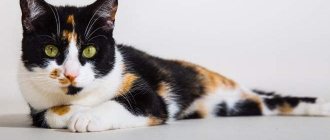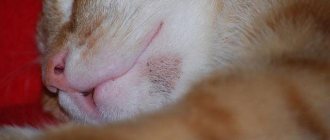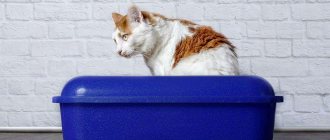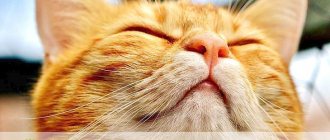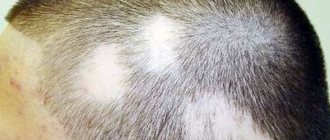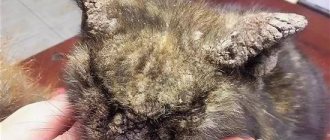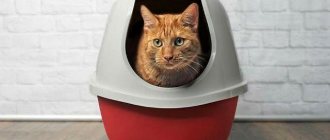Vomiting in a cat is most often a protective reaction of the body, with the help of which the animal rids the stomach of mechanical impurities. This is a natural physiological process that does not require human intervention. But if the cat starts vomiting white foam, then this is an alarming sign.
The cause of the appearance of foam in vomit can be both physiological and pathological factors, including dangerous viral infections. Let's find out how to help your pet at home before the veterinarian arrives.
Why does a cat vomit white foam?
The causes of white foam vomiting in a cat can vary. Normally, an animal regurgitates during a long period of absence of food. In this way, the pet gets rid of excess gastric juice, which irritates the mucous membrane and can cause inflammation and the formation of ulcerative areas.
Physiological causes of white foam vomiting in a cat also include:
- accumulation of hair in the stomach;
- accidental ingestion of foreign bodies that can be found in vomit;
- eating plant stems (cats swallow them to cleanse their stomachs of fur);
- severe stress or prolonged stay in a state of nervous tension;
- sexual hunting;
- compression of the abdominal organs by the growing uterus during pregnancy;
- toxicosis during pregnancy;
- motion sickness in transport;
- taking certain medications.
Important! To help your cat get rid of hair in its stomach, it should be fed grass with tough stems (wheatgrass). The hairs stick to them easily and firmly, and then come out when the cat regurgitates them along with saliva.
Causes of vomiting in kittens
When a kitten is breastfed, the cause of vomiting may be the cat's consumption of poor-quality food, medications, or medications.
Usually, when this factor is eliminated, vomiting stops. But if, after weaning from its mother at the age of 1-2 months, the kitten begins vomiting white foam, then this may be due to the following reasons:
- abrupt transfer from breastfeeding to commercial feed or natural products;
- overeating or swallowing large pieces of food;
- swallowing large amounts of fur hairs when licking;
- ingestion of inedible objects.
These factors in most cases do not pose a threat to life. They are easily corrected by changing the diet and increased attention to the care of animals.
But owners should know that 2 months is a dangerous age for kittens. At this time, the immune cells obtained from mother's milk cease to cope with maintaining resistance, and babies have not yet formed their own immunity.
This allows infectious agents to easily enter the body and cause dangerous diseases.
Often the first sign of the development of pathology at 2 months is the kitten vomiting white foam. Among such conditions are:
- poisoning with drugs or chemicals, inhalation of vapors of toxic or toxic substances;
- helminthiases (larvae of parasites can be found in foamy vomit);
- inflammatory processes in the gastrointestinal tract (gastritis, colitis);
- viral diseases.
Important! Veterinary experts do not recommend treating lactating cats against ecto- and endoparasites. But sometimes owners neglect this rule, which negatively affects the health of the offspring. If after this procedure the kitten vomits white foam, exhibits lethargy, convulsions, loss of coordination or other nervous phenomena, then it must be urgently hospitalized.
Vomiting in cats
If the cat occasionally burps white foam and at the same time looks active and maintains his appetite, then nothing needs to be done. But if vomiting occurs frequently and is accompanied by other clinical signs, then consultation with a specialist is necessary, as this may indicate the development of the disease.
A cat vomits white foam when the following viral pathologies develop:
- panleukopenia;
- calicivirus;
- coronavirus enteritis.
In these diseases, vomiting is a consequence of severe intoxication, which occurs due to dysfunction of the gastrointestinal tract, dehydration and rapid breakdown of cells in the animal’s body under the influence of viruses. Since the cat does not eat anything, he vomits only white foam without foreign impurities.
The cause of foamy vomiting can be chronic diseases of the digestive system:
- gastritis;
- colitis;
- dystrophic changes in the liver.
Metabolic disorders that cause a cat to vomit white foam include ketoacidosis. It develops in diabetes mellitus under the influence of stress or poor nutrition.
Vomiting white foam in a cat can periodically occur with chronic renal failure and chronic pancreatitis. Relapses of these diseases are provoked by an imbalance of water balance in the body, errors in diet, poisoning or stress.
With chronic renal failure, in addition to the fact that the cat vomits white foam, the following also occurs:
- thirst;
- constipation;
- the appearance of an unpleasant odor from urine, hair and breath;
- stomatitis;
- pallor of the visible mucous membranes and the inner surface of the ears;
- convulsions.
Important! During an attack of acute pancreatitis, the cat first vomits saliva mixed with bile and pancreatic juice. Since the urge to vomit does not stop, and vomiting does not bring relief, the cat vomits foam. Pancreatitis is also indicated by tension in the abdominal wall and severe pain.
Helminthiasis is another reason why a cat vomits liquid with foam. This is due not only to general intoxication and a large accumulation of parasites in the intestines, but also to the penetration of larvae into the lungs during the migration period.
Reflex foamy vomiting in cats can occur with inflammatory diseases of the respiratory tract with a severe hacking cough.
If a cat is vomiting white foam, suddenly losing weight and not eating anything, it is worth checking the animal for the presence of tumors in the gastrointestinal tract.
In case of poisoning, vomit most often contains the remains of undigested food and bile. However, with prolonged vomiting, when the stomach becomes empty, the cat begins to vomit only white foam.
Constipation and intestinal obstruction can also be attributed to the reasons why a cat regurgitates saliva mixed with foam. This is due to severe intoxication of the body, lack of appetite and pain. Since constipation is often accompanied by thirst, after drinking liquid the cat vomits water and foam. This is a very alarming sign that indicates intestinal obstruction. In such a situation, you need to urgently take the animal to the clinic.
Causes of vomiting in kittens
The cat is vomiting bile and doesn’t eat anything: what to do?
A baby may vomit due to the following factors:
- with a sharp change in the usual diet, especially during weaning from mother’s milk and transition to solid food;
- prepared food of low quality or feeding scraps from the master's table: fatty, smoked, salted, spoiled foods, due to which the stomach is automatically cleansed;
- absorption of food in large pieces (observed in hungry kittens);
- accumulation of fur in the gastrointestinal tract during active licking;
- swallowing foreign objects. Any inedible things become a source of problems and can cause pink vomit;
- poisoning - consumption of medications, detergents, cosmetics, alcoholic beverages or cat litter;
- after vaccination.
Important! Regardless of the source of the kitten's gag reflex, it is necessary to show it to a veterinarian. In complex cases, the problem may be associated with liver diseases, pancreatitis, triaditis, and infectious diseases.
First aid
If frequent vomiting occurs, you should call a veterinarian. However, every owner should know what to do at home before the doctor arrives if the cat is vomiting white foam. To alleviate the animal’s condition and draw up a more complete clinical picture, the following manipulations should be performed:
- remove food from the animal’s field of vision;
- provide free access to clean water;
- conduct an examination of the mucous membranes;
- palpate the stomach and neck area;
- measure temperature (if possible);
- determine the presence of other symptoms.
This will help the veterinary specialist quickly collect anamnestic data, make the correct diagnosis and carry out treatment.
Important! If the cat vomits suddenly, you need to check the integrity of containers with household chemicals, medications, alkalis and acids that the pet could have accidentally accessed.
Chepa Natalya Semenovna
Veterinarian
Ask a Question
How to understand whether vomiting is physiological or not. If you know the reason, for example, the animal ate something from the table or overate, and except for a one-time vomiting the cat is not bothered by anything, it is active, mobile, it has a normal temperature, there is no diarrhea, there is no blood in the vomit, there is no reason for concern. First aid in such cases depends on the cause. If you are vomiting with hairballs, you need to start giving malt paste to remove hair. If the animal has pulled out a foreign object: grass, a piece of bone, you can give an enveloping drug, for example sucralfate (1/4 tablet per cat). For animals prone to overeating, the portion size is reduced. Repeated vomiting, especially in combination with any other symptoms, requires immediate contact with a veterinary clinic.
Pivot table
| Cause | What to do |
| Wool | Regular brushing, malt paste |
| Grass | Observation |
| Feed | Power change |
| Hunger | Feed more often |
| Binge eating | Feed more often and in small portions |
| Foreign body | Treatment in a clinic setting |
| Pregnancy | Diagnostics |
| Estrus | Diagnostics |
| Medicines | Treatment in a clinic setting |
| Stress | Eliminating stress and prescribing sedatives |
| Surgical interventions | Treatment in a clinic setting |
| Viral infections | Treatment in a clinic setting |
| Vaccination | Vomiting is often one-time, no treatment required |
| Pathologies of the digestive system | Treatment in a clinic setting |
| Kidney diseases | Treatment in a clinic setting |
| Oncology | Treatment in a clinic setting |
| Sepsis | Treatment in a clinic setting |
| Helminths | Treatment for helminths |
When to contact a veterinarian
Many people try to cope with the problem on their own, but do not know what exactly to do when a cat starts vomiting with white foam. It is strictly forbidden to eliminate this symptom with Cerucal injections or other drugs.
Vomiting is a protective mechanism by which the body gets rid of unnecessary substances. Therefore, if vomiting is repeated in an animal more than 2 times a day, accompanied by depression and other clinical signs, then contacting a veterinarian is a mandatory procedure.
Diagnosis and treatment
For proper treatment, it is necessary to establish the exact reason why the cat is vomiting white foam. To do this, the doctor prescribes blood, urine and stool tests, and also uses instrumental methods.
After a visual examination and collection of anamnestic data, a veterinarian makes a preliminary diagnosis, depending on which additional examinations are prescribed.
Investigations for suspected infectious diseases:
- general and biochemical blood test;
- urine analysis for the presence of protein, blood cells and pathogenic bacteria;
- conducting immunological tests to identify a specific pathogen;
- bacterial seeding of pathological material on nutrient media to identify the causative agent of infection;
- X-ray of the chest for the presence of inflammatory processes in the organs of the respiratory system;
- Ultrasound of the abdominal cavity.
List of possible studies for suspected chronic pathologies of the digestive system:
- general and biochemical blood test;
- Liver tests (if necessary):
- coprogram;
- Ultrasound of the abdominal organs;
- endoscopy;
- X-ray to identify foreign bodies in the esophagus or stomach.
To identify kidney failure when a cat is vomiting white foam, the following tests are necessary:
- general and biochemical blood test;
- general urine analysis;
- Ultrasound of the kidneys.
In case of poisoning, cats are prescribed a blood test. But sometimes it is impossible to identify a specific toxic substance in ordinary veterinary laboratories. Therefore, the doctor relies on clinical signs, changes in the smell of breath and urine, and the nature of vomiting.
To determine helminthiases, you will need a coprogram and a general blood test.
To identify tumors the following is prescribed:
- general and biochemical blood test;
- X-ray with contrast agent;
- Ultrasound of the abdominal and thoracic organs;
- endoscopy.
In large clinics, CT, MRI and diagnostic laparoscopy are performed, in which the affected tissue fibers are taken for histological examination.
After making a diagnosis and identifying the exact cause of the cat's white foam vomiting, the veterinarian begins to treat the animal. To do this, he directs efforts to eliminate the main factor that caused vomiting, and also prescribes symptomatic therapy.
Anti-vomiting medications for cats
Centrally acting antiemetic drugs are prescribed only by a veterinarian after the exact cause of vomiting has been established. These products include Cerucal and Torekan. They gently reduce the intensity of the gag reflex and prevent its subsequent manifestations.
Together with these medications, the doctor prescribes medications that minimize the secretion of hydrochloric acid in the stomach. Among them are:
- Almagel;
- Omez;
- Famotidine;
- Omepool;
- Omeprazole.
You can also relieve vomiting with the help of No-shpa, Papaverine or Drotaverine, which are antispasmodics.
Use of antibiotics
Antibiotics are prescribed to cats only when vomiting is caused by pathogenic bacteria. Such pathologies include inflammatory processes in the respiratory system and gastrointestinal tract.
The most commonly used antibacterial drugs in veterinary medicine are:
- Sinulox;
- Tsiprovet;
- Doxycycline;
- Baytril.
Antibiotics are also prescribed if the cat is vomiting white foam as a result of chronic renal failure and the animal is at risk of developing a kidney infection.
Diet food
With frequent and intense vomiting, the animal needs a starvation diet with unlimited access to water. After the condition improves, ready-made medicinal feed can be introduced. If the cat ate natural food, then raw and fatty foods should be excluded from its diet.
Important! Spicy, pickled, fried and sweet foods, as well as canned food intended for humans, are strictly prohibited even for healthy cats.
List of prohibited and recommended foods for vomiting.
| Prohibited Products | Healthy foods |
| Bakery products | Boiled eggs |
| Fat meat | Chicken without skin and fat |
| River fish | Rabbit meat |
| Sour cream | Turkey breast |
| Butter | Puree of zucchini, cauliflower, carrots and pumpkin |
| Whole milk | Oatmeal, rice and buckwheat porridge |
| Fresh vegetables and fruits | Cottage cheese |
| Pearl barley and semolina | |
| Millet | |
| Hard cheese |
How is the intestines connected to well-being?
The most common symptoms of intestinal dysfunction are united under the collective concept of intestinal dyspepsia. These include bloating, increased gas formation, rumbling in the abdomen, diarrhea, constipation or alternation of constipation (unsteady stools), discomfort and abdominal pain. These symptoms can be caused by an unhealthy lifestyle, long-term use of medications, stress, or insufficient production of digestive enzymes due to the presence of various diseases of the gastrointestinal tract, and in particular the intestines. Constantly recurring symptoms of intestinal dyspepsia cause a deterioration in the quality of life. Therefore, when such symptoms appear and, especially, when they recur frequently, in order to undergo effective treatment and get rid of them, the help of a gastroenterologist is necessary.
Intestinal diseases and disorders can affect various processes in the body and cause symptoms that are not always clearly indicative of the intestines. These include weakness, loss of strength, skin problems, hair loss, low mood, joint pain, they are also called extraintestinal. In addition, the imbalance between normal and pathogenic microorganisms that make up the microflora also affects the well-being and health of a person and can contribute to the development of inflammatory processes in the body.
You can get advice from a gastroenterologist specializing in the diagnosis and treatment of intestinal diseases at the Expert Gastroenterological Center.
Preventive measures
To prevent attacks of white foam vomiting in cats, you should adhere to the following rules:
- carry out timely deworming;
- monitor the quality of feed;
- store household chemicals and medications in places inaccessible to your pet;
- Do not let the animal outside unattended.
If your cat begins to vomit white foam, you should not self-medicate or try to eliminate this symptom on your own. It is necessary to contact a veterinarian and conduct a comprehensive study to identify the causes of its occurrence. Only in this way will it be possible to minimize the risk of deterioration of the animal’s condition and the development of serious complications.



